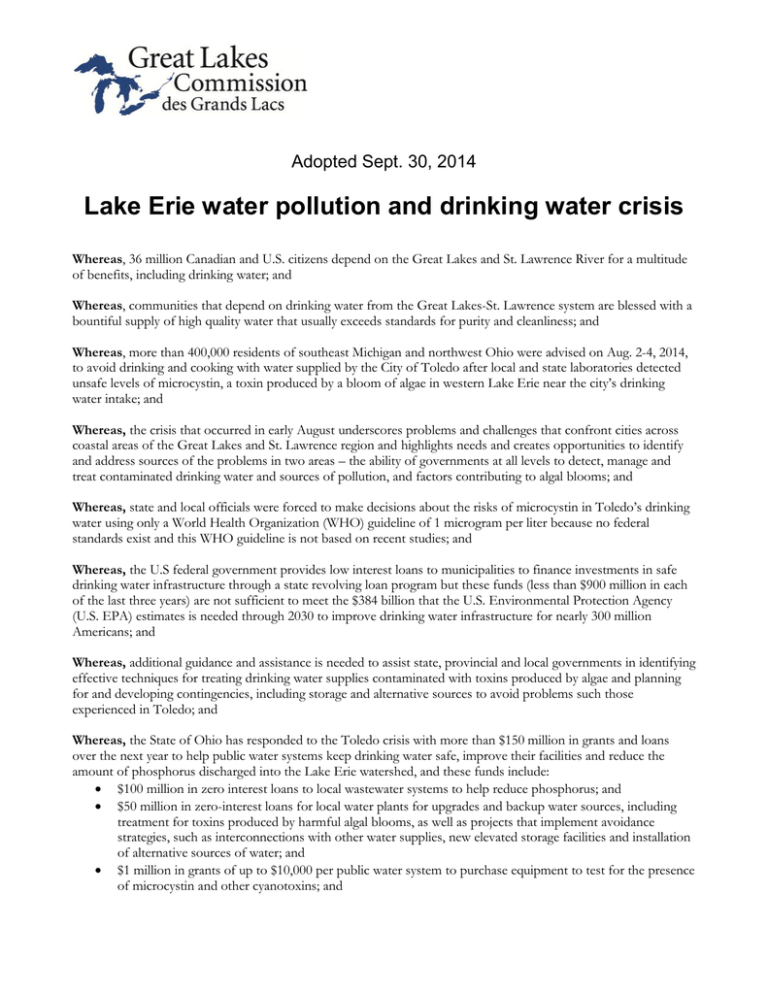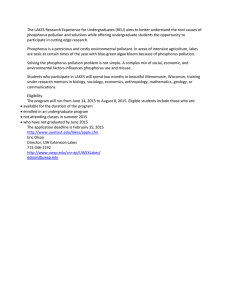Lake Erie water pollution and drinking water crisis
advertisement

Adopted Sept. 30, 2014 Lake Erie water pollution and drinking water crisis Whereas, 36 million Canadian and U.S. citizens depend on the Great Lakes and St. Lawrence River for a multitude of benefits, including drinking water; and Whereas, communities that depend on drinking water from the Great Lakes-St. Lawrence system are blessed with a bountiful supply of high quality water that usually exceeds standards for purity and cleanliness; and Whereas, more than 400,000 residents of southeast Michigan and northwest Ohio were advised on Aug. 2-4, 2014, to avoid drinking and cooking with water supplied by the City of Toledo after local and state laboratories detected unsafe levels of microcystin, a toxin produced by a bloom of algae in western Lake Erie near the city’s drinking water intake; and Whereas, the crisis that occurred in early August underscores problems and challenges that confront cities across coastal areas of the Great Lakes and St. Lawrence region and highlights needs and creates opportunities to identify and address sources of the problems in two areas – the ability of governments at all levels to detect, manage and treat contaminated drinking water and sources of pollution, and factors contributing to algal blooms; and Whereas, state and local officials were forced to make decisions about the risks of microcystin in Toledo’s drinking water using only a World Health Organization (WHO) guideline of 1 microgram per liter because no federal standards exist and this WHO guideline is not based on recent studies; and Whereas, the U.S federal government provides low interest loans to municipalities to finance investments in safe drinking water infrastructure through a state revolving loan program but these funds (less than $900 million in each of the last three years) are not sufficient to meet the $384 billion that the U.S. Environmental Protection Agency (U.S. EPA) estimates is needed through 2030 to improve drinking water infrastructure for nearly 300 million Americans; and Whereas, additional guidance and assistance is needed to assist state, provincial and local governments in identifying effective techniques for treating drinking water supplies contaminated with toxins produced by algae and planning for and developing contingencies, including storage and alternative sources to avoid problems such those experienced in Toledo; and Whereas, the State of Ohio has responded to the Toledo crisis with more than $150 million in grants and loans over the next year to help public water systems keep drinking water safe, improve their facilities and reduce the amount of phosphorus discharged into the Lake Erie watershed, and these funds include: $100 million in zero interest loans to local wastewater systems to help reduce phosphorus; and $50 million in zero-interest loans for local water plants for upgrades and backup water sources, including treatment for toxins produced by harmful algal blooms, as well as projects that implement avoidance strategies, such as interconnections with other water supplies, new elevated storage facilities and installation of alternative sources of water; and $1 million in grants of up to $10,000 per public water system to purchase equipment to test for the presence of microcystin and other cyanotoxins; and Whereas, algae blooms in western Lake Erie, like blooms in other parts of the Great Lakes, are triggered by a variety of factors, including physical changes like warmer waters, more intense storms, changes in nutrient cycling through the food web associated with invasive mussels, and increased phosphorus pollution from a variety of sources, including point and nonpoint sources; and Whereas, billions of dollars are being spent annually by state, federal and provincial governments to encourage farm practices that reduce erosion and improve nutrient management, including $9.5 billion over the last three years for U.S. Department of Agriculture conservation activities, yet many of these programs and practices can be of limited duration, are dependent on the sustainability of federal support, are subject to change based on prices of crops, and there is little information on the whether these programs and practices are targeted at the most important sources; and Whereas, the International Joint Commission (IJC) and the State of Ohio’s Phosphorus Reduction Task Force have called for setting a load target at 800 metric tons (1,763,680 pounds) for total phosphorus and 150 metric tons for dissolved reactive phosphorus entering Lake Erie from the Maumee River in the spring (March-June), representing 37 percent and 41 percent reductions, respectively, compared to the average spring phosphorus loads between 2007 and 2012, while calling for similar reductions in phosphorus loads from other parts of the western Lake Erie basin; and Whereas, the U.S. and Canadian federal governments are working under Annex 4 of the Great Lakes Water Quality Agreement to set phosphorus loading targets for Lake Erie by 2016; and Whereas, loading targets should reflect the impact of invasive mussels on cycling and availability of nutrients, while new technologies, including biological-based agents such Zequanox, hold promise as possible agents to manage invasive mussels, and these agents require immediate testing on safety and efficacy; and Whereas, states have the primary authority and responsibility for implementing clean water programs through delegation under the U.S. Clean Water Act, with Ontario executing clean water programs under its own authority and in cooperation with the Canadian federal government under the Canada-Ontario Agreement Respecting the Great Lakes Basin Ecosystem. Therefore, Be It Resolved, that the Great Lakes Commission calls on U.S. EPA and Environment Canada to work with the states of Michigan, Indiana and Ohio and the province of Ontario to take appropriate actions, following the recommendations of the IJC’s February 2014 Lake Erie Ecosystems Priority report and the Ohio Lake Erie Phosphorus Reduction Task Force Report of 2013, to protect water quality in Lake Erie, with a focus on the western basin; and Be It Further Resolved, that state and provincial members of the Great Lakes Commission are committed to protecting Lake Erie and will work together and with federal agencies, municipal officials and landowners to reduce water pollution and assist local municipalities in providing safe drinking water; and Be It Further Resolved, that the members of the Great Lakes Commission commit to forming a working group to: develop new and refine existing practices, programs and policies (i.e., TMDL and GLWQA Annex 4 processes) or specify nutrient concentration guidance value(s) by jurisdiction(s), working collaboratively, necessary to achieve pollutant reduction targets or remedies as might be identified by the working group and to achieve objectives set forth in the U.S. Clean Water Act and the Great Lakes Water Quality Agreement; and explore and advance market-based and other cost-effective incentive programs to complement regulatory and non-regulatory approaches to strengthen the effectiveness and sustainability of the overall management regime for improving water quality and safeguarding drinking water in Lake Erie and other Great Lakes; and Adopted at the 2014 Annual Meeting of the Great Lakes Commission, Sept. 30 in Buffalo, N.Y. Be It Further Resolved, the Great Lakes Commission urges federal agencies to work with states, provinces, local municipalities, landowners and technical experts to develop and implement an adaptive management framework for agricultural conservation and water quality protection programs that monitors and evaluates the performance of voluntary and regulatory conservation practices and facilitates improvements to strengthen their effectiveness and sustainability; and Be It Further Resolved, the Great Lakes Commission calls on U.S. EPA and Environment Canada to jointly develop and establish national health advisory levels for microcystin and other cyanotoxins, including advisory levels for acute and short-term exposure risks with tiered levels for more susceptible populations such as children and infants; and Be It Further Resolved, the Great Lakes Commission calls on Congress to fully fund the Drinking Water State Revolving Fund and that federal governments in both the United States and Canada should provide funding to support the planning, design and construction of needed infrastructure improvements to treat and or avoid cyanotoxins; and Be It Further Resolved, the Great Lakes Commission urges federal agencies to work in collaboration with the Great Lakes Commission and state, provincial, municipal officials and other experts to: Identify more precisely the drinking water infrastructure investment status and needs for cities in Great Lakes states and provinces and share this information with decisionmakers to encourage increased funding; Identify and share information on techniques and practices to assist local governments in detecting, monitoring and reporting toxins related to algae; Identify and share information on practices to effectively treat drinking water contaminated with cyanobacteria; and Identify and share information on options to provide redundancy and contingencies in water supply; and Be It Finally Resolved, the Great Lakes Commission calls on federal agencies, including the Department of Fisheries and Oceans Canada, the U.S. Geological Survey and the National Oceanic and Atmospheric Administration, to collaborate with states, provinces, the Great Lakes Commission and the Great Lakes Fishery Commission to develop protocols for testing and supporting investigations and field trials on the efficacy and safety of biological-based controls such as Zequanox for the management of zebra and quagga mussels. Adopted at the 2014 Annual Meeting of the Great Lakes Commission, Sept. 30 in Buffalo, N.Y.



